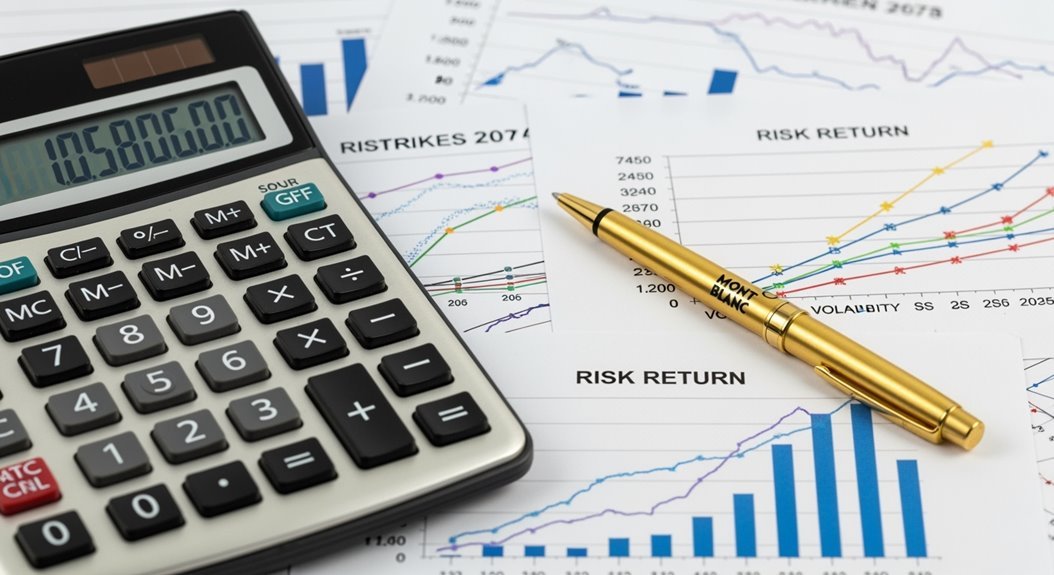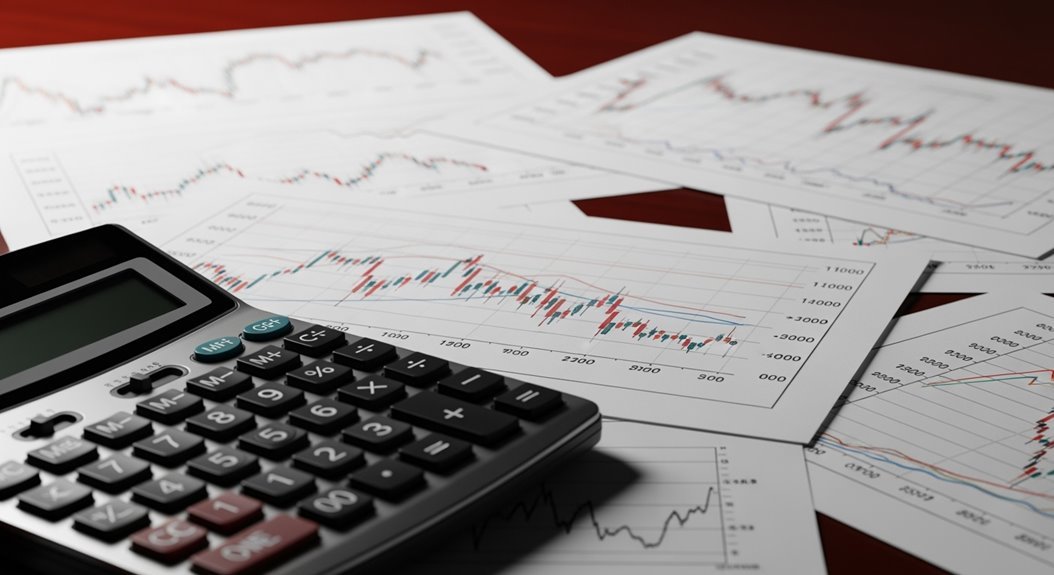The Sharpe ratio measures risk-adjusted returns in options trading by comparing excess returns above the risk-free rate to strategy volatility. The formula (Rp – Rf) / σp divides portfolio returns minus risk-free rates by standard deviation. Ratios above 1.0 indicate adequate performance, while above 2.0 suggests good results. Options trading complicates traditional interpretations due to leverage, extreme skewness, and fat tails that distort risk measurements. Professional desks typically operate within 1-2 ratios, though additional metrics reveal deeper insights.
Understanding the Sharpe Ratio Formula and Its Components

Risk-adjusted returns. That’s what the Sharpe Ratio measures. Developed by economist William Sharpe in 1966, this metric compares excess returns to volatility.
The formula is straightforward: (Rp – Rf) / σp. Three components drive everything.
Portfolio return (Rp) represents the average return generated over a specific period. Simple enough.
Risk-free rate (Rf) serves as the baseline. Usually government bonds or Treasury Bills. The theoretically riskless investment.
Standard deviation (σp) measures volatility. How much returns jump around. Higher standard deviation equals more risk.
Subtract the risk-free rate from portfolio return. This isolates excess return—the extra compensation for taking risk beyond safe investments.
Divide that excess return by standard deviation. The result? Your Sharpe Ratio.
Higher ratios indicate better risk-adjusted performance. Lower ratios suggest inadequate compensation for volatility. Negative ratios? The portfolio underperformed risk-free assets.
It’s about efficiency. Getting maximum return per unit of risk taken. A Sharpe ratio above 1 generally indicates superior risk-adjusted returns compared to the market. However, calculations can use either forecasted or historical data, which may affect the reliability of results.
The Sharpe Ratio helps assess investment performance against the risk-free rate, making it particularly useful for comparing different portfolios.
Applying Sharpe Ratio Analysis to Options Trading Strategies
Options traders face a complex challenge. They must balance potential returns against significant risks inherent in leveraged positions. The Sharpe ratio becomes their analytical compass, guiding strategy evaluation through risk-adjusted performance metrics.
Smart traders time their entries using technical indicators. MACD signals momentum shifts. RSI identifies overbought conditions. Bollinger Bands reveal volatility patterns. These tools optimize entry and exit points, boosting returns while controlling exposure.
| Strategy Element | Risk Control Method | Sharpe Impact |
|---|---|---|
| Position Sizing | Volatility-based allocation | Reduces drawdowns |
| Stop Losses | ATR-based exits | Limits tail risks |
| Diversification | Multiple strikes/assets | Lowers correlation |
| Rebalancing | Regular portfolio review | Maintains optimization |
Position sizing aligned with volatility measures prevents catastrophic losses. Normal distribution assumptions may not accurately capture the extreme risk events common in options trading. Stop-loss orders based on Average True Range manage leverage risk effectively. Diversifying across underlying assets and strike prices reduces portfolio correlations.
Continuous backtesting with AI tools guarantees strategies adapt to changing markets. Regular Sharpe ratio evaluation keeps performance on track. Higher Sharpe ratios indicate superior risk-adjusted returns that help identify overlooked high-performing options strategies. Weekly timeframes often deliver superior Sharpe ratios compared to daily trading due to reduced transaction costs and market noise.
Interpreting Sharpe Ratio Results and Recognizing Limitations
Understanding what Sharpe ratio numbers actually mean separates successful traders from those chasing misleading metrics. Common wisdom suggests ignoring strategies below 1.0 post-costs. Ratios above 2 are good. Above 3? Exceptional for hedge funds.
But options trading breaks these rules. Hard.
The Sharpe ratio assumes normal return distributions. Options laugh at this assumption. Their returns show extreme skewness and fat tails that distort risk measurements completely. A high Sharpe ratio might hide devastating tail risk lurking beneath seemingly stable returns.
High-frequency strategies game the system. They generate artificially high ratios through frequent small profits while minimizing measured volatility. Real economic risk? Hidden.
The ratio treats all volatility equally. It can’t distinguish between profitable upside swings and portfolio-killing downside moves. Maximum drawdowns and tail events—the metrics that actually matter for survival—remain invisible in Sharpe calculations.
The Sharpe ratio’s backward-looking nature compounds these problems by failing to predict future performance in changing market conditions. The ratio’s extreme measurement period sensitivity can distort apparent performance when comparing different timeframes. Smart traders supplement with conditional value at risk and maximum drawdown metrics instead. These alternative approaches consider extreme market conditions that traditional Sharpe ratio calculations fail to capture.
Calculating and Comparing Performance Across Different Options Portfolios

When traders calculate Sharpe ratios for options portfolios, they’re diving into messy mathematical territory where standard formulas meet non-standard realities. Options portfolios demand daily return data. Monthly figures miss too much action.
The math stays simple: (Rp – Rf) / σp. But options complicate everything underneath. Leverage amplifies volatility. Expiration dates create time decay. Non-linear payoffs skew distributions.
Smart traders annualize using 252 trading days, not calendar days. They match risk-free rates to holding periods. Short-term options? Use T-bills. Longer strategies? Treasury bonds work better.
Comparing portfolios requires identical timeframes and benchmarks. A covered call strategy’s Sharpe ratio means nothing against a straddle portfolio unless both use same data periods and risk-free rates. Many platforms begin their calculation starts five trading days after the first position is established to ensure statistical validity.
Higher Sharpe ratios win. Period. But options traders shouldn’t stop there. Professional trading desks often operate with ratios between 1 and 2, making extremely high backtested ratios suspect. Tail risks hide in options portfolios. The Sharpe ratio misses extreme events that can destroy accounts overnight.
Frequently Asked Questions
Can Sharpe Ratio Predict Future Options Trading Performance?
The Sharpe ratio shows limited predictive power for future options performance. It relies on historical data that may not reflect changing market conditions. Options trading involves non-normal returns and tail risks that Sharpe ratios miss entirely. Studies reveal correlation weakens during volatility regime shifts. The metric works best alongside other measures like maximum drawdown and value-at-risk rather than standalone forecasting.
How Does Implied Volatility Changes Affect Sharpe Ratio Calculations?
Implied volatility changes hit Sharpe ratios from both ends. Rising IV boosts option premiums, potentially increasing returns for sellers. But it also amplifies price swings, inflating the risk measure in the denominator. The result? Unpredictable ratio movements. Higher volatility doesn’t automatically mean worse risk-adjusted performance – it depends which effect dominates. Traders must track IV shifts constantly to maintain accurate performance metrics.
Should I Use Daily or Monthly Returns for Options Sharpe Ratio?
The choice depends on trading frequency and strategy horizon. Active options traders benefit from daily returns—they capture volatility spikes and premium swings that monthly data smooths over. Daily calculations require annualizing by multiplying the square root of 252 trading days. Monthly returns work better for longer-term strategies, reducing noise and providing stability. High-frequency traders need granular daily data for accurate risk assessment.
What’s a Realistic Sharpe Ratio Target for Retail Options Traders?
Retail options traders should target Sharpe ratios between 0.5 and 1.0. Anything below 0.5 signals poor risk-adjusted performance. Above 1.0 is possible but requires disciplined risk management and favorable markets. Professional hedge funds hit 1.0 to 2.0, but retail traders face higher costs, smaller capital, and emotional biases. Options’ inherent volatility and leverage make these targets harder to sustain consistently.
Does Sharpe Ratio Work for Single Options Positions Versus Portfolios?
Sharpe ratio struggles with single options positions. Options have asymmetric payoffs and non-normal return distributions that violate the ratio’s core assumptions. Standard deviation doesn’t capture skewness or tail risks inherent in individual options. Portfolios work better. Diversification smooths volatility and normalizes returns, making Sharpe ratio more reliable. Single option ratios fluctuate wildly due to leverage and path dependency. Greeks and scenario analysis provide better risk assessment.



